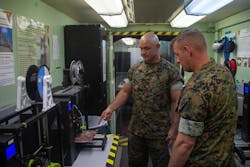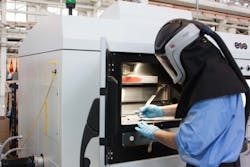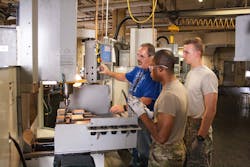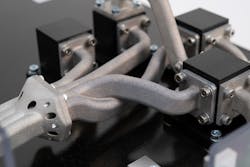By Megan Crouse
NASHUA, N.H. - Even within heavy industries, people often speak of 3D printing in terms of science fiction. With the allure of creating something from nothing, it has been poised to revolutionize prototyping, manufacturing, and resupplying for decades. However, additive manufacturing — another name for 3D printing — also is a reality here and now.
Numerous 3D printing companies offer ready-made menus of different materials and techniques. Some experts say it’s still the way of the future, while others say no one process (or array of sub-processes) can do all the things 3D printing promises to do. So which is it: practical or over-promised?
First, what’s the difference between 3D printing and additive manufacturing? The term 3D printing is used more often in hobbyist spaces. You can find commercial and hobbyist printers using inexpensive plastics in elementary schools and public libraries. It’s in relatively common use in manufacturing facilities and the schools that train the workers who use them. Broadly speaking, the process of laying down material from the top down onto a print bed is 3D printing.
Different sources argue over whether additive manufacturing is a more general or a more specific description. What people tend to agree on, however, is that additive manufacturing is the more professional term, implying the product that results is part of a larger mechanical or electronics project, rather than a novelty.
Manufacturers provide many different types of additive manufacturing: powder bed fusion, binder jetting, material extrusion, or directed energy deposition are just some of the different types. Additively manufactured products fall under specific categories named under American Society for Testing and Materials (ASTM) standards. So, all additive manufacturing involves 3D printing, but not all 3D printing is for additive manufacturing.
Military additive manufacturing
Using it in military applications adds even more specific sets of standards and requirements. This process helps to create replacement or original parts, as well as create prototypes. All of those uses means additive manufacturing has an influence on military logistics, too, changing the way in which parts can be delivered into service.
It’s an area in which the industry is putting a lot of attention and money. Many companies either are throwing their metaphorical hats into the ring to adapt to additive manufacturing or have solid standing in the sector already and are generating profits.
The U.S. Defense Advanced Research Projects Agency (DARPA) in Arlington, Va., recently concluded the Transformative Design (TRADES) program, which ran from 2017 to 2020. The project sought to approach additive manufacturing from the software side, to “advance the foundational mathematics and computational tools required to generate and better manage the enormous complexity of design.”
Experts from the American Society of Mechanical Engineers in New York traced the origins of 3D printing to the 1980s. They credit Hideo Kodama of NagoyaMunicipal Industrial Research Institute in Nagoya, Japan, with the first patent for a recognizable modern 3D printer in 1980. However, his invention did not receive wide attention or adoption.
But from there, more and more people pursued the idea of commercializing a similar idea. Companies still known widely in the industry began in this era, such as Stratasys Inc. in Eden Prairie, Minn. Founders Scott and Lisa Crump filed a patent for a fused deposition modeling machine in 1989. EOS GmbH in Krailling, Germany, was another major player, where laser sintering research work started in 1989. AeroMet, a division of MTS Systems in Eden Prairie, Minn., performed the first public metal printing process, using lasers to fuse titanium alloys, in 1997.
Since then, use of additive manufacturing has expanded through medical devices, aerospace, automotive engineering, the arts, and other fields. Military applications have proliferated as well, from parts to shelters for storing vehicles to small submarines. Packaging, heat sinks, RF antennae, the internals of PC boards, and more are all being printed for use in the defense industry today.
“We’re seeing it all over the airplane,” says Dale Tutt, vice president of aerospace and defense for Siemens Digital Industries Software in Plano, Texas. “I first started using some printed parts when we were needing special shapes of ducts for environmental control systems. It was easier to 3D print those parts to get the shape we needed in the space we had available to us. In space you’re seeing engine nozzles and even entire rockets being 3D printed now. I’m even starting to see some pretty substantial parts in large titanium frames, major structural elements.”
Additive Manufacturing drawbacks
Before designers can start working with 3D printing, they need to be able to set the machines up, align the process with standards, and know how to validate the end product. This has proven a challenge, as it might with any new technology. So-called “cultural rigidity” is holding additive manufacturing back in the world of military applications. After all, military work tends to rely on proven, staid standards — which helps when it comes to the safety and reliability of the equipment, but can hurt innovation.
The hype itself has been a problem, because only about 5 percent of the additive manufacturing industry is active in aerospace and defense, suggests AviationWeek and industry advisor Lauren Ely. In addition, insufficient training, challenging business cases, and a lack of 3D-printed applications suited to aerospace and defense create a gap between ability and reality, or even between reality and what sells.
In a June 2020 article, Aviation Week noted that several barriers remain in place between military aerospace applications and additive manufacturing. Printers are proving not to be up to snuff, and standards and training are both lacking. Many printed products require further finishing, which can be time- and money-consuming.
During the COVID-19 pandemic, the manufacturing powers of companies using additive manufacturing for military applications turned toward personal protection equipment (PPE) instead. Boeing plants across the country produced printed products, but they weren’t for planes — they were for face shields. Airbus and Raytheon Technologies similarly retooled to produce face shield headbands and other PPE.
Lack of standards also can be a problem. Siemens’s Tutt says his company is trying to make this easier as part of the build process itself. “Another trend is how do we accelerate some of the regulatory processes? When you’re developing parts using additive tech there are still some regulatory hurdles. It gets down to how well you can design and analyze the parts, how well you can control the allowables, how well you can document the process.”
To that effort, they are using machine learning to develop the allowables from a particular additive manufacturing process and machine, which in the end means they need to do fewer tests on that product.
Tutt says systems designers who may be excited about adoptive additive manufacturing tend to ask a lot of questions about how their tools overcome regulatory hurdles.
“Our customers often ask how do we use simulation, how do we use the design tools and even the manufacturing analysis tools to help overcome that. I think that’s the most common barrier to adoption. [But] there’s a lot of excitement around wanting to adopt additive.”
The newness of the processes presents opportunity and challenges. “We don’t have the 50 years of learning we have with other materials out there,” Tutt says. “I think confidence will continue to increase, regulatory confidence will increase.”
The upside to additive manufacturing
Speed of use and versatility sum up what makes additive manufacturing different. It can produce complex internal geometry that would be too difficult to design and manufacture on traditional machines. Using relatively inexpensive prints, designers can make prototyping quickly because iteration is limited only by the speed of the print.
When it comes to aerospace electronics, the space sector is one of the areas finding the widest use of additive manufacturing. Since commercial low-Earth products are themselves cutting-edge, the standards for their creation and the standards for additive manufacturing can be developed hand-in-hand.
“In the U.S., we think in the very near term we’d be on space platforms because of the benefit of SWAP needs and the embracing of complexity to solve those problems,” says Emile de Rijk, CEO of SWISSto12 SA in Renens, Switzerland.
Cobham Advanced Electronic Solutions (CAES) in Arlington, Va., and SWISSto12 have bet big on additive manufacturing with an agreement to bring RF applications for the aerospace and defense industry to U.S. customers. By the end of the year, CAES officials say they plan to set up a new manufacturing facility using SWISSto12 technology and intellectual property.
With additive manufacturing “you break free from a lot of manufacturing limitations that you had that would constrain your design space,” says SWISSto12’s de Rijk. “That enables you to design products to be more complex, more lightweight, with more RF features for extra performance.”
This helps solve the traditional problem where an RF designer takes a plan to a mechanical designer, who says “no way we’re doing this,” de Rijk says. Often that designer will impose limitations that can restrict the product to half of its functionality in the process. Additive manufacturing can help solve that problem for several reasons.
Starting at the design stage, de Rijk says, additive manufacturing can help designers create products that solve a lot of problems all at the same time. “Have an RF problem solve a mechanical problem solve a thermal problem” rather than having three different parts, he says. He predicts this will become more practical in the next couple years as designers become more comfortable with the interconnects; the engineers themselves need to see more of what is possible in connecting them. At the same time, the industry is seeking smaller and smaller satellites, and smaller and smaller radars. Companies like SWISSto12 are angling to be ready when the prime contractors go looking for ways to interconnect those things.
Designing-in interconnects
Dave Young, chief technology officer of CAES, also notes that additive manufacturing allows for combining different parts into one product. It makes designing interconnects easier, he says. And defense industry prime contractors have expressed interest, Young says, because while they may be set in their ways, trusted secondary vendors have more flexibility to experiment with new things.
Experts at his company have been working with additive manufacturing long enough that there isn’t a case of something that might happen in the future; it’s something they know how to work with well now, but still are looking for new use cases.
“We could do it in the past, but there were performance [problems],” CAES’s Young says. “The weapons systems never wanted to trade performance for any of the other factors ...With Emile’s tech, we’ve demonstrated we can increase the performance or at least be on par with the same agility additive manufacturing brings to other elements and the same cost reductions they bring to other elements.”
In aerospace and defense, we build things that need to work, Young continues. “When there’s a need to build something state-of-the-art we do that and are comfortable with the risk.”
This returns us to the cons: sometimes, a potential additive manufacturing project is not worth the risk. If designers can build a piece with subtractive manufacturing just as well, adding the risk of additive isn’t appealing.
However, he says, in the last five to seven years there have been more cases of metal printing and other breakthroughs that mean additive works well in aerospace. Now, “It’s just part of our toolset. We don’t talk about whether we’re using a lathe or a 3D-capable machine. It’s just machining ...It’s a different arrow in our quiver.”
This works particularly well for RF applications, de Rijk says, because of the mechanical complexity inherent in RF designs. RF relies on different signal pipelines, which are “very intricate, very small, quite small tolerances.” This is buried inside the structure. Additive manufacturing gives them the ability to cut metal inside something else “after three bends and still be precise,” de Rijk says. “We don’t have to break it into pieces, machine it off, and build it together ... Generating interfaces, accommodating screws ... additive manufacturing can build hollow structures with a lot of complexity.”
When it comes to military applications, RF electronics must be small enough to sit inside a small nosecone and survive launch conditions. Additive manufacturing can improve some of what can be done inside that format. Designers can “solve problems with simplicity instead of complexity,” Young says.
More applications
That drive toward simplicity extends to the traceability of the product as well, says Siemens’s Tutt. As part of this role, his team looks for intersection points where designers’ needs match the company’s product lines.
“The beauty of additive engineering, design, and manufacturing with Siemens products is the fact that you have that vital thread from when you first start designing the part, analyzing it, doing topology optimization, light-weighting, printing, finishing and inspecting,” Tutt says. “We’ve been able to connect all of those processes together and provide a complete digital thread with traceability from the design part to the manufacturing part. That’s something that makes [Siemens] unique: we have the design, engineering and manufacturing pieces.
“The benefits that we see in a couple different areas, speaking specifically to electronics packaging, is the ability to get form factors and shapes you wouldn’t usually get from packaging,” Tutt continues. “Where we see customers looking now is 3D printing antennae for commercial applications that instead of producing it flat you’re now producing it in shapes more tailored for the need of the antenna maybe, as well to the shape of where you would install it on an aircraft. It’s still early days, but that’s one application.”
Additive manufacturing also can help designers with thermal management and electronics cooling. “Electronics have so much heat, and need usually pretty elaborate heat sinks,” Tutt says. “They’re trying to produce these heat sinks in sometimes pretty confined spaces and get that heat to outside of the box so they can cool the box off. Instead of machining channels and then creating an assembly of a heat sink you can print those right into a heat sink. So it’s a one-step process now.”
Military and aerospace electronics designers are asking for more material options and solutions scaled to fit most effectively in limited spaces. Siemens is working on combining topology optimization software and the intricate inner architecture enabled by additive manufacturing.
“Everyone’s always trying to bring the size of the products down. Sometimes the size is driven by the thermal dissipation and the size of the boards, obviously, but often they have contrasts in size. They’re always trying to bring weight down and additive offers opportunity for [lightweighting by using fewer parts],” Tutt says.
Additive manufacturing in the future
So, what’s next? The additive manufacturing machines themselves are improving. Meanwhile, Tutt is seeing a need for his people to work on how companies can do a better job of predicting the allowables and the processes of the manufacturing. That would mean they can design the parts better from the jump, and, hopefully, therefore produce the parts better by the end of the line as well.
Another area in which cutting-edge work is still being done is with printing metals. In this area, there are some persistent thermal management problems that tendWhen discussing what 3D-printed products might be able to offer that conventional ones cannot, Tutt returns to the idea of digital traceability.
“Traceability in the process is key — simulation and analysis tools to predict not just the behavior of the part in the field but to predict the manufacturing process. And that’s going to be critical —
that understanding and that traceability — as we move into verifying the part and certifying it and overcoming regulatory hurdles. Even as you transition into sustainment over time you now have the part data and can just print off a new part if you need to.”
Over time, companies will learn culture or process lessons from the development of composite materials as they move on from early adoption. As more companies started to develop them, they created a roadmap for clearing hurdles.
Most people in the business world know the saying: you can only find a product that does two out of three when it comes to making something high-quality, fast, and inexpensive. For Tutt’s part, Siemens sees two major factors — cost and time to produce — that could go down because of the opportunities presented by additive manufacturing.
“As we’ve seen over time, maybe this is a bit of an industry perspective from me leading engineering programs for a long time, it’s not just digital connotations of the additive point of view but we’re seeing benefits from SWaP ... but we’re also seeing the price coming down. The crossover points are starting to change. Maybe in the past due to cost the numbers of parts you needed to print was large compared to the number that would need to be printed for aerospace. But, now, the cost of the machines are coming down, so the cost is becoming much more manageable.”
In some cases, Tutt has seen production time going from 100 days to 100 hours. That speed is just one of the factors that organizations must keep in mind when considering whether to integrate additive manufacturing into their processes and purchases.







